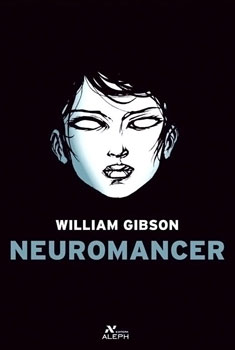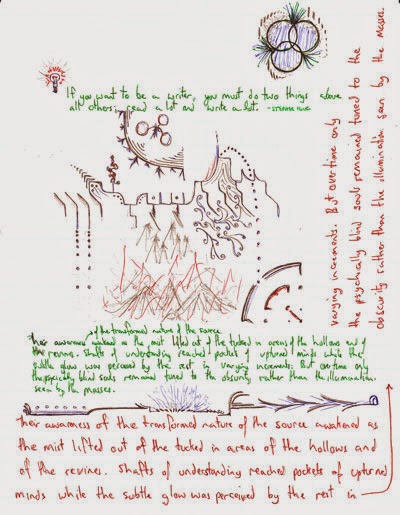 "The sky above the port was the color of television, tuned to a dead channel." The first line of William Gibson's 1984 novel, Neuromancer, brilliantly describes the environment of his futuristic landscape with an image of now-deceased technology. He writes in his forward, "The reader never stopped to think that I might have been thinking, however unconsciously of the texture and color of a signal-free channel on a wooden-cabinet Motorola with fabric-covered speakers. Readers compensated for me, shouldering an additional share of the imaginative burden, and allowed whatever they assumed was the color of static to take on the melancholy of the phrase 'dead channel.'" Gibson's Neuromancer helped establish the foundation of cyberpunk: that genre tied to Blade Runner, Ghost in the Shell, Deus Ex, and the Matrix. As I have come to figure out my own influences, the things that tweak my way of looking at the world, it seems that Gibsons's work has affected me quite dramatically. I am drawn to and repulsed by the world he creates in his novel. It's like my relationship with Facebook these days; I hate it and can't lay off it at the same time. The works and allusions defined by Gilson's extension of the northeastern Megalopolis, "The Sprawl," in part led me away from my Baltimore and Boston roots to seek more mountainous landscapes. Intrigued by the creative and often disruptive uses of technology in the hands of the young and brilliant has also made me hunger for things mechanical and analog. I play on computers all day long, but find that my creations that are most pleasing to me are often pencil and ink. I know there is balance, that I need a balanced environment, that technology and nature can have a healthy relationship; the fun of his story is that it offers none. It is out of control and on the edge. Jacking in to the net, careening through a digital landscape, and breaking though to the other side... it's a rush! Recovery—is a cup of green tea at sunset under the aspens in autumn.
"The sky above the port was the color of television, tuned to a dead channel." The first line of William Gibson's 1984 novel, Neuromancer, brilliantly describes the environment of his futuristic landscape with an image of now-deceased technology. He writes in his forward, "The reader never stopped to think that I might have been thinking, however unconsciously of the texture and color of a signal-free channel on a wooden-cabinet Motorola with fabric-covered speakers. Readers compensated for me, shouldering an additional share of the imaginative burden, and allowed whatever they assumed was the color of static to take on the melancholy of the phrase 'dead channel.'" Gibson's Neuromancer helped establish the foundation of cyberpunk: that genre tied to Blade Runner, Ghost in the Shell, Deus Ex, and the Matrix. As I have come to figure out my own influences, the things that tweak my way of looking at the world, it seems that Gibsons's work has affected me quite dramatically. I am drawn to and repulsed by the world he creates in his novel. It's like my relationship with Facebook these days; I hate it and can't lay off it at the same time. The works and allusions defined by Gilson's extension of the northeastern Megalopolis, "The Sprawl," in part led me away from my Baltimore and Boston roots to seek more mountainous landscapes. Intrigued by the creative and often disruptive uses of technology in the hands of the young and brilliant has also made me hunger for things mechanical and analog. I play on computers all day long, but find that my creations that are most pleasing to me are often pencil and ink. I know there is balance, that I need a balanced environment, that technology and nature can have a healthy relationship; the fun of his story is that it offers none. It is out of control and on the edge. Jacking in to the net, careening through a digital landscape, and breaking though to the other side... it's a rush! Recovery—is a cup of green tea at sunset under the aspens in autumn.The doodles below are some of what came out of me during trainings and meetings soon after my most recent reading of Neuromancer. I can only assume they are my brain working through some of the images that Gibson conjured up in my subconscious as I tried to share in shouldering some of the imaginative burden...
The skyline disrupted the natural chaos of the union between earth and air. Order and purpose marred the jagged edge, cutting smooth curves and precise angles where organic geological lines formerly existed. Their presence spoke of effort, planning, diction. Deep roots leeched from below disproportionately, allowing growth beyond what would have been in a natural state. And yet this was their nature, to do what their will willed them to do. The planning looked forward, never to what used to be... what should be.
Their monitors, like eyes wide in the darkness, searched for the irregular movement of pinpoints of light in the vast field of heavenly objects... searched for evidence of a return on their efforts... searched for the proof to warrant their long held faith that they could not be so alone in such a creation. They yearned for contact beyond themselves, forgetting that they already were in communication...
Their awareness of the transformed nature of the source awakened as the mist lifted out of the tucked in areas of the hollows and of the ravines. Shafts of understanding reached pockets of upturned minds while the subtle glow was perceived by the rest in varying increments. But over time only the psychically blind souls remained tuned to the obscurity rather than the illumination seen by the masses.
The frameworks from which they were operating had foundations in a singular directional orientation, that being time-based-forward. The existence of, the presence of, the awareness of the other forced some to accept a multi-directional, nay, an a-directional reality allowing for the unlimited potentials within "union".






